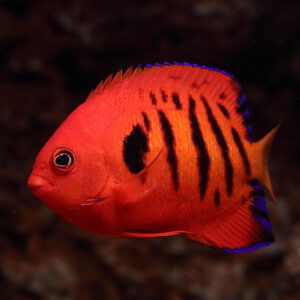The Copperband Butterfly, Chelmon rostratus, is a captivating fish known for its distinctive appearance. It features a slender, elongated body with prominent vertical copper-coloured bands. The maximum size of the Copperband Butterfly can reach up to 8 inches (20 cm) in length, making it a medium-sized fish that adds elegance to any aquarium.
Natural Habitat:
In the wild, the Copperband Butterfly inhabits the Indo-Pacific region, including the Red Sea, East Africa, and various Pacific islands. These fish are often found in shallow coastal reefs, lagoons, and protected outer reef areas. They prefer areas with abundant corals, rocky substrates, and ample hiding spots. The vibrant colours of the coral reefs provide a beautiful backdrop for the Copperband Butterflyfish’s copper bands.
Keeping Copperband Butterfly Healthy:
The care level of the Copperband Butterfly is considered moderately difficult, as they have specific requirements that need to be met for their well-being. They can be delicate and challenging to acclimate properly, so experienced aquarists are recommended for their care. Maintaining pristine water conditions, stable temperature, and proper nutrition is crucial. Regular monitoring and timely intervention are needed to address any potential health issues.
Special Requirements and Feeding:
Copperband Butterfly have a specialized diet consisting primarily of small invertebrates. Their diet should include live or frozen foods such as worms, copepods, amphipods, and bristleworms. It may be necessary to offer alternative food options, like high-quality pellets or frozen mysis shrimp, to ensure a well-rounded diet. Providing ample hiding places, such as live rock structures, is important to make the fish feel secure.
How Many Should I Keep?
It is recommended to keep only one Copperband Butterfly per tank. They can be territorial toward their own species or similar-looking fish. Providing ample swimming space and hiding spots for individual fish is essential for their well-being.
Lighting Preference:
Copperband Butterfly do not have specific lighting preferences. They can adapt well to a variety of lighting conditions, ranging from moderate to high intensity.
Suitable Tank Mates:
When considering tank mates for the Copperband Butterfly, it is important to choose peaceful species that are not overly aggressive or territorial. Avoid keeping them with other butterflyfish, as they may exhibit aggression towards each other. Suitable tank mates can include other peaceful community fish, such as small tangs, wrasses, gobies, or cardinalfish. However, always monitor their behaviour closely to ensure compatibility.
Reproduction:
In the wild, Copperband Butterfly form pairs during the breeding season. They engage in courtship rituals, which involve swimming together, displaying vibrant colours, and performing various movements to attract mates. Once a pair is formed, they search for a suitable location to spawn.
Spawning typically occurs around dawn. The female releases a large number of eggs into the water column while the male simultaneously releases sperm to fertilize them. The eggs are buoyant and rise towards the surface, where they drift with the currents. This dispersal strategy increases the chances of the eggs encountering suitable conditions for development.
The hatched larvae, known as fry, go through a pelagic phase where they float in the water column. During this period, they rely on their yolk sac for nourishment. The fry undergo several developmental stages, gradually transforming their body shape and developing fin structures.
Breeding Chelmon rostratus:
Breeding the Copperband Butterfly, Chelmon rostratus, in captivity is quite challenging and rare. Their complex reproductive behaviours, specific environmental conditions, and dietary requirements make successful breeding difficult to achieve in a home aquarium setting.
In captivity, reproducing Copperband Butterfly is even more challenging. The specific environmental conditions required for successful breeding are difficult to replicate in a home aquarium. However, a few successful breeding attempts have been reported in large, well-maintained aquariums with dedicated breeding setups.
To encourage breeding, replicating natural conditions as closely as possible is crucial. This includes providing a suitable environment with ample hiding places, live rock structures, and carefully controlled water parameters. A separate breeding tank can be set up with stable temperature and appropriate lighting conditions.
In some cases, hormone injections or specialized diets may be used to induce spawning. However, these methods are not commonly practiced and are typically limited to professional breeding facilities or research institutions.
Breeding Copperband Butterfly remains a rare occurrence in captivity, and most individuals available in the aquarium trade are collected from the wild. It’s important to support sustainable collection practices and prioritize the well-being of these delicate fish when considering their presence in an aquarium.
Please note that successful breeding of Copperband Butterfly requires extensive knowledge, experience, and specialized equipment. It is not recommended for inexperienced aquarists and should be undertaken with a strong commitment to ethical and responsible practices.
Sexual Dimorphism:
There are no prominent external differences between male and female Copperband Butterfly. Sexual dimorphism in this species is not visually apparent, making it challenging to determine their gender solely based on physical characteristics.
Distribution:
The Copperband Butterfly, Chelmon rostratus, is found in the Indo-Pacific region, including the Red Sea, East Africa, and various Pacific islands. While they are often collected from the wild, there are also captive-bred and line-bred strains available in the aquarium trade. The original wild fish primarily comes from their natural habitats in the Indo-Pacific region.
Summary:
The Copperband Butterfly, Chelmon rostratus, is a captivating fish known for its striking appearance and graceful movements. With their elongated body adorned by vertical copper-coloured bands, they bring a touch of elegance to any aquarium.





Reviews
There are no reviews yet.